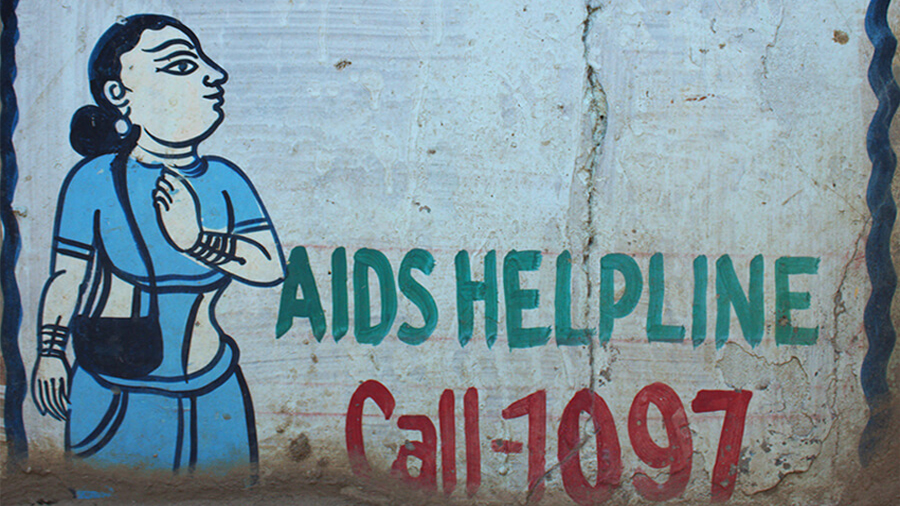Design Elements in Health and Wellness
This blog is part of the series of blogs on Aspur Project under the Primary Healthcare Initiative (PHI), a partnership between Basic Healthcare Services and Centre for Healthcare.
“Yeh jo Shipra PHC hain, woh bilkul Prakruti ki Godh par hain,” exclaimed Bhagawan ji in his usual poetic demeanor as we approached the Shipra PHC. Bhagawan ji, a WASH consultant with UNICEF India, was our point of contact to take us to PHCs in and around Indore. After visiting the PHC in Bhawati village, in Barwani block, on the first day of fieldwork, we visited the PHC in Shipra, on the outskirts of Indore, on our second day. The field visit was to conduct interviews with staff from PHCs that have shown exemplary performance in adhering to standard protocols of Water, Sanitation, and Hygiene (WASH) and health guidelines on behalf of the Primary Healthcare Initiative (PHI), a partnership of Basic Health Care Services and Centre for Healthcare at the Indian Institute of Management Udaipur.
The Shipra PHC stood true to Bhagawan ji’s description. Situated close to the bank of river Shipra, towering trees, creating a canopy, formed the archway to the PHC. The chirping of the birds, the occasional leaping of squirrels, and the sunlight filtering through the lush foliage radiating dappled patterns on the ground filled us with rejuvenation and solace. The Shipra PHC defied the stereotypical image of a government hospital many of us would hold in India: sordid, dilapidated, and mundane. Although it might sound counterintuitive considering a hospital’s association with illness and diseases, the PHC at Shipra was marked by an inviting environment.
Hospitals and aesthetics/ designs have always been considered mutually exclusive. Particularly in a developing country like India, where the staff, infrastructure, quality, and accessibility of services are all lacking in the health system, the aspect of design in healthcare is often considered superfluous. However, in this blog, I would like to shed light on the potential impact of these seemingly less-emphasized design aspects and how they enhance accessibility, engagement, and understanding in healthcare settings.
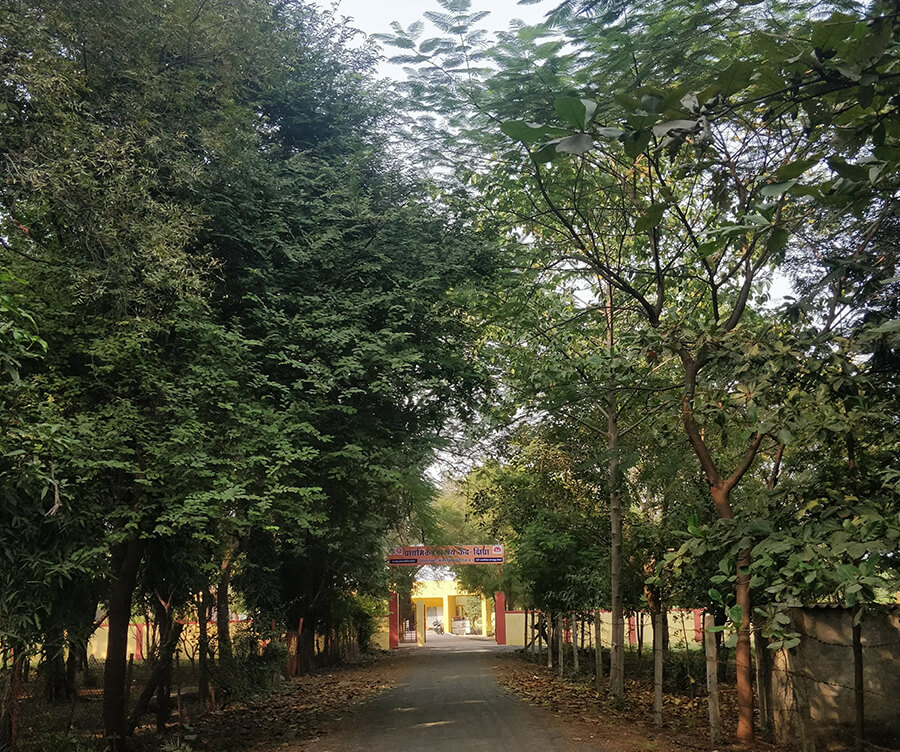
PHC Shipra, Madhya Pradesh Photo by Srividya Ramanathan
Layout Design
While hospitals, as structures, are primarily marked with a sense of utilitarianism rather than architectural grandeur, numerous studies have shown measurable impacts of hospital design on patient outcomes.1 Social design, referring to the design of relationships, including those invisible and intangible, is being increasingly adopted in the design of healthcare spaces.1 For instance, in Butaro, a poorly resourced area in Northern Rwanda rife with infectious diseases, the district hospital was built in 2011 on a hilly site to maximize cool air circulation in the interior with outdoor rest areas where patients can sit comfortably in shady spots. Trees and shrubs were planted on the surrounding hills to stabilize the soil, create shade, and provide soothing views of greenery.2
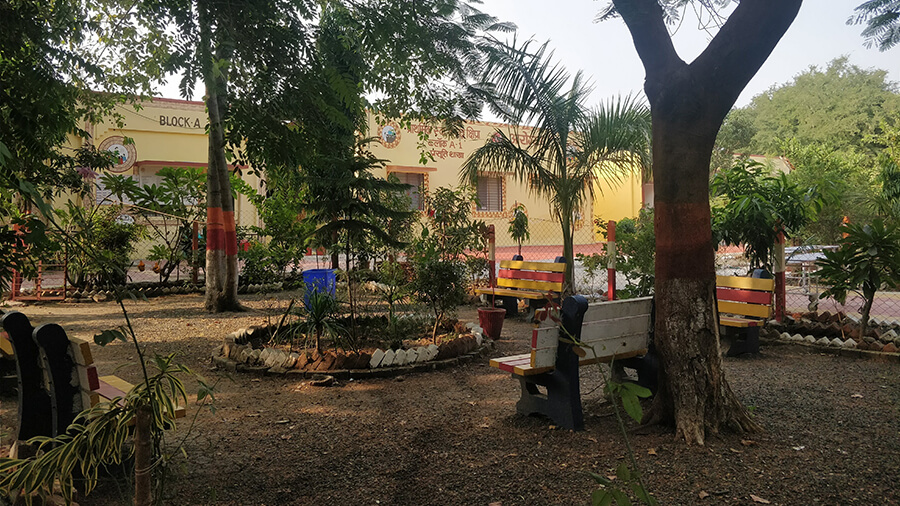
PHC Shipra, Madhya Pradesh Photo by Srividya Ramanathan
Pregnant women, recently delivered mothers, and patient companions at the Shipra PHC unanimously praised one particular feature – the hospital’s expansive and lush green surroundings. Kavita ji3 , who was staying at the hospital as a birth companion with her daughter, shared that the outdoor space had been a respite from the confines of the hospital room. The vast exterior, adorned with abundant greenery and comfortable stone benches, has become the designated waiting area for visitors of expecting mothers and outpatients.
For relatives traveling afar to visit the pregnant women, the lush green premises become a space to rest and unwind. A nursing staff from the PHC mentions that she and her colleagues have lunch in the garden on the stone benches and adds, “Hum yahan shanti mahasoos karte hn”, a sentiment that was met with agreement from her colleagues. Coincidentally, studies evidence that increased greenery and views of gardens boost nursing staff retention and alleviate pain and stress perceptions among patients.3
Similar to the PHC in Shipra, Narayana Hrudyalaya, a private hospital network with heart centres across major cities, demonstrates effective space utilization by incorporating outdoor waiting areas within the expanse of the outdoor greenery in their Mysore center. Further, the hospital building has been designed to minimize electricity consumption by optimizing natural daylight and facilitating cross ventilation. Limiting the hospital site to a single-story building and extensive use of prefabricated trusses instead of traditional reinforced cement concrete construction (RCC) also expedited the hospital construction, serving as a testimony to efficient and sustainable practices4 .
Wayfinding Design
Navigating hospitals when the stress of the illness itself is high can be daunting. In BHS-operated low-cost AMRIT clinics in rural and underserved regions of Rajasthan, when a patient is referred to secondary or tertiary hospitals in nearby towns or cities, they send someone along to assist these patients in navigating the intricate health system. However, when an effective wayfinding design is in place, it becomes intuitive.
Effective wayfinding is not just about plain text instructions but also about communicating through visuals, especially for those who may be unable to read. Visual cues could act as a compass that guides, reducing disorientation and alleviating the stress often accompanying a hospital visit. Recently, when visiting a telemedicine clinic in rural Gujarat, a recurring issue caught our attention. Residents of the town where the clinic is situated often found it difficult to understand and locate the clinic due to the cluttered and convoluted signage. The purpose of the telemedicine provider was to facilitate access to quality healthcare in remote regions, but the signage was creating a barrier, obscuring the clinic’s visibility

PHC Shipra, Madhya Pradesh Photo by Srividya Ramanathan
Visual Design
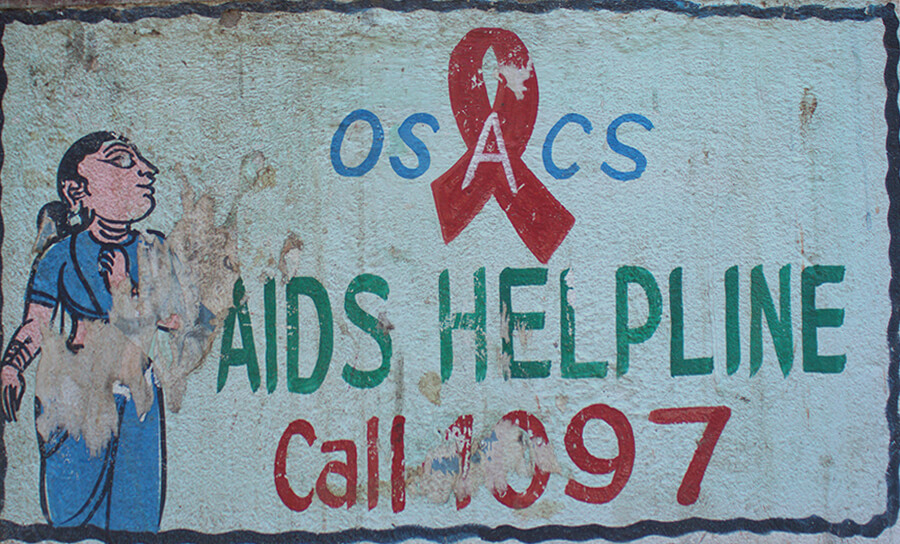
Raghurajpur, Odisha Photo by Srividya Ramanathan
While effective wayfinding design becomes the guiding compass, effective visual design in healthcare instills a sense of community engagement and better uptake and engagement. In our journey through healthcare environments in different corners of the country, we have witnessed the profound impact of visual designs in healthcare in forging connections with the local communities. In Raghurajpur in Odisha, a village known for its Pattachitra paintings, we stumbled upon many HIV/ AIDS campaigns on walls, executed in the Pattachitra style. Another example is in Rajasthan, where CFH’s healthcare initiatives are primarily centered; the wall art adorning hospital premises and other public spaces to promote healthy behaviors and raise awareness about various health issues is rooted in the local culture. You will find visuals of women in ghooghats and poshaks and men in a Rajasthani pagri and dulangi dhoti. More than being mere imageries, they serve as relatable symbols for the local communities. Seeing visuals in public service announcements that mirror their own cultural identity fosters a sense of connection.
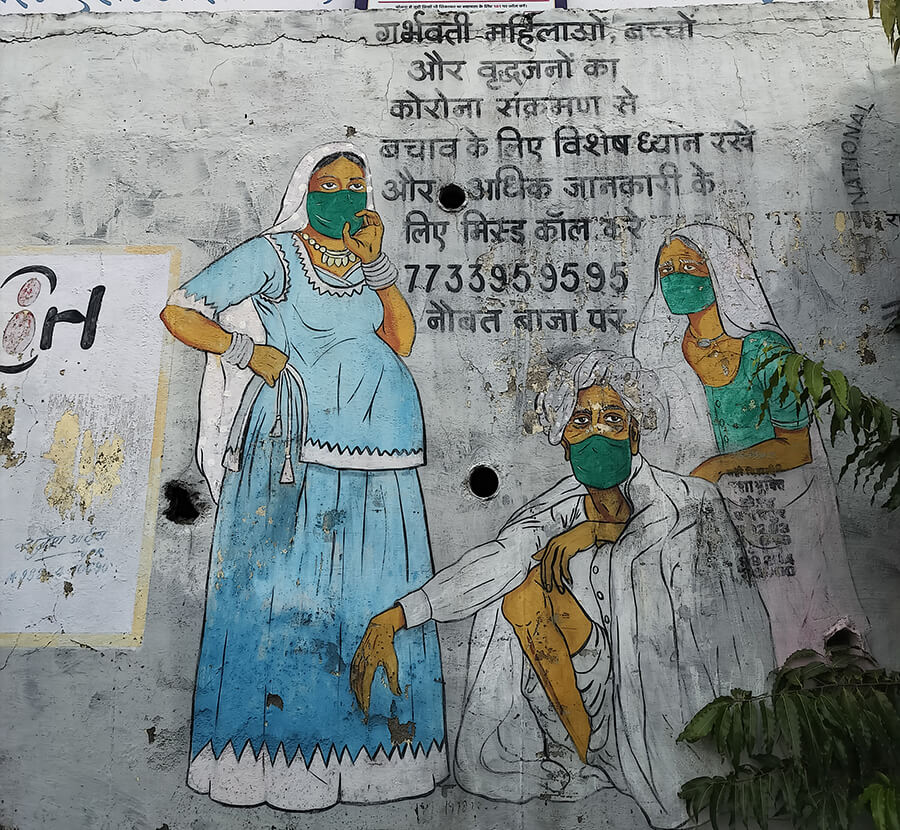
Wall art at a urban PHC in Udaipur, Rajasthan Photo by Srividya Ramanathan
Another case of ingenious visual branding is the 1,50,000 Health and Wellness Centres (HWCs) created under the Ayushman Bharat to deliver comprehensive care. With the intent to enhance accessibility and inclusivity, the branding approach allows each HWC to personalize the building facade with its local art/ craft patterns. The template features six circles and a rectangle, a basic representation of the six primary services the HWCs provide is illustrated in the six circles. The parallel border lines can be adorned with local patterns, giving the center its unique character5 (refer to the image below).
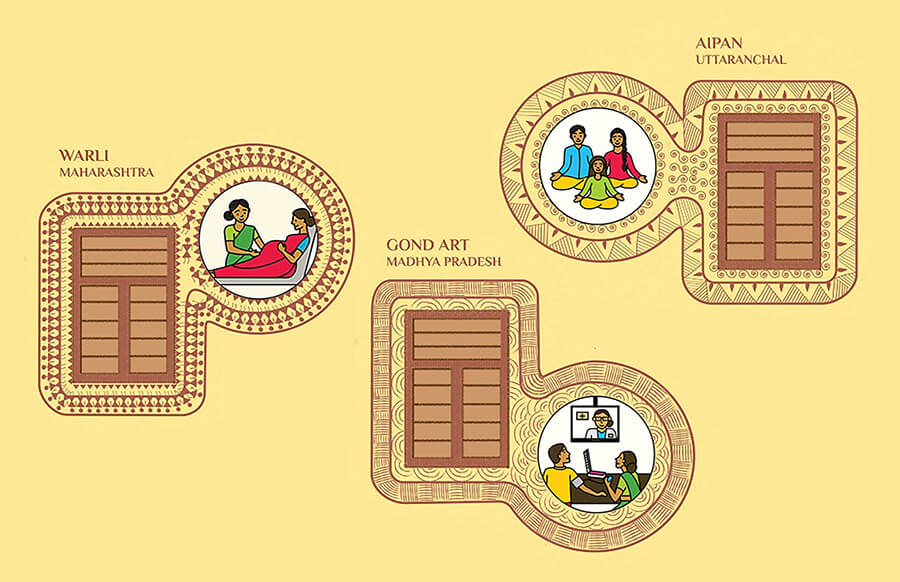
Space between the parallel lines adorned with craft/art patterns unique to the state
Image Source: https://thisislopez.com/project/branding-for-ayushman-bharat
Information Design
Much like the other facets of the design explored above, information design plays a pivotal role in shaping the healthcare experience. Effective information design can range from prescription labels, automated appointment reminders to public health campaigns and patient information leaflets. It can take various forms, whether through written or oral communication, such as a conversational style PSA video or catchy radio jingle. In healthcare, using straight and clear language is paramount. Yet, incorporating human-interest dimensions to establish an emotional connection or weaving humor elements makes it engaging. For instance, the Ministry of Health and Family Welfare’s (MOHFW) TV campaign on oral contraceptives infuses human interest dimensions and uses simple language to bust misconceptions about oral contraceptives (link to the TV campaign: India TV campaign on oral contraceptive pills). Starting by grabbing the reader’s attention, organizing the information for easy comprehension, encouraging interaction with the readers through questions or calls to action, and offering practical examples when designing healthcare IEC materials could make them valuable tools to bridge the providers and patients. For instance, the below digital poster on TB eradication, strategically employs the hashtag #TBMuktBharat to attract attention to content focused on TB awareness. Notably, the use of the color red for the helpline number, website, and the message addressing the importance of not discriminating against TB patients is a well-thought-out strategy. As per color psychology, red is associated with a sense of urgency, and the inclusion of red in call-to-actions encourages conversions and active actions6 .
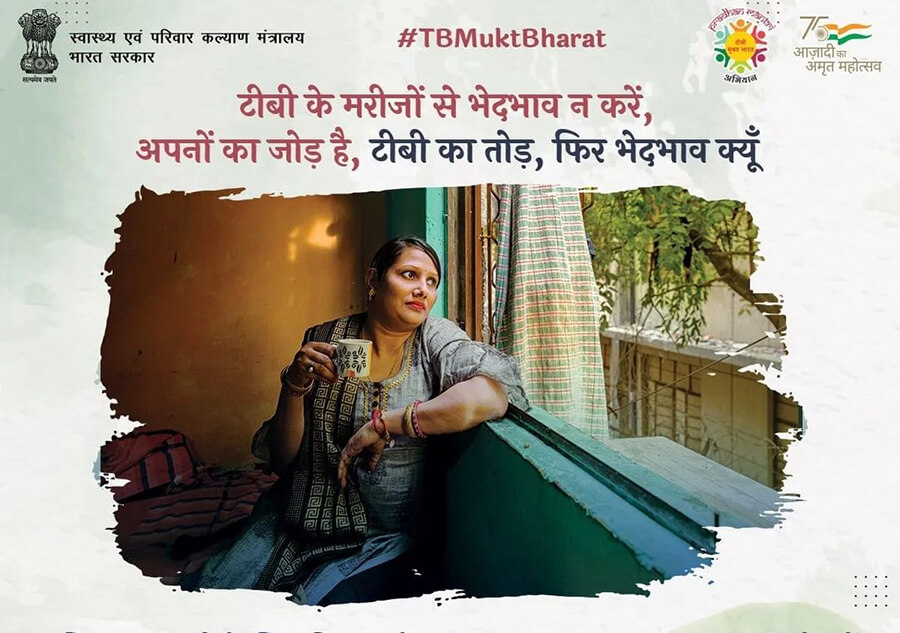
Incorporating a call to action, be it a phone number or a website link for further information is crucial
Image Source: https://www.instagram.com/mohfwindia/?hl=en

Comprehensive educational material on infant health presented in a succinct and instructional manner on an MCP card
Image Source: nhm.gov.in
In essence, the consideration of design in hospital settings and healthcare delivery is a crucial aspect of compassionate and effective health delivery. Investing in design elements is not merely a matter of aesthetics but a strategic imperative, too.
References
- https://hbr.org/2018/10/how-the-architecture-of-hospitals-affects-health-outcomes
- https://massdesigngroup.org/index.php/work/design/butaro-district-hospital
- Pseudonym
- https://www.sdmimd.ac.in/SDMRCMS/cases/CIM2013/6.pdf
- https://thisislopez.com/project/branding-for-ayushman-bharat
- https://blog.hubspot.com/the-hustle/psychology-of-color
